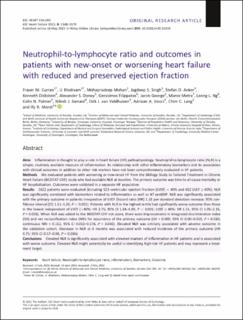| dc.contributor.author | Curran, Fraser M. | |
| dc.contributor.author | Bhalraam, U. | |
| dc.contributor.author | Mohan, Mohapradeep | |
| dc.contributor.author | Singh, Jagdeep S. | |
| dc.contributor.author | Anker, Stefan D. | |
| dc.contributor.author | Dickstein, Kenneth | |
| dc.contributor.author | Doney, Alexander S. | |
| dc.contributor.author | Filippatos, Gerasimos | |
| dc.contributor.author | George, Jacob | |
| dc.contributor.author | Metra, Marco | |
| dc.contributor.author | Ng, Leong L. | |
| dc.contributor.author | Palmer, Colin N. | |
| dc.contributor.author | Samani, Nilesh J. | |
| dc.contributor.author | van Veldhuisen, Dirk J. | |
| dc.contributor.author | Voors, Adriaan A. | |
| dc.contributor.author | Lang, Chim C. | |
| dc.contributor.author | Mordi, Ify R. | |
| dc.date.accessioned | 2022-04-21T09:29:29Z | |
| dc.date.available | 2022-04-21T09:29:29Z | |
| dc.date.created | 2022-01-24T09:28:03Z | |
| dc.date.issued | 2021 | |
| dc.identifier.issn | 2055-5822 | |
| dc.identifier.uri | https://hdl.handle.net/11250/2991891 | |
| dc.description.abstract | Aims
Inflammation is thought to play a role in heart failure (HF) pathophysiology. Neutrophil-to-lymphocyte ratio (NLR) is a simple, routinely available measure of inflammation. Its relationship with other inflammatory biomarkers and its association with clinical outcomes in addition to other risk markers have not been comprehensively evaluated in HF patients.
Methods
We evaluated patients with worsening or new-onset HF from the BIOlogy Study to Tailored Treatment in Chronic Heart Failure (BIOSTAT-CHF) study who had available NLR at baseline. The primary outcome was time to all-cause mortality or HF hospitalization. Outcomes were validated in a separate HF population.
Results
1622 patients were evaluated (including 523 ventricular ejection fraction [LVEF] < 40% and 662 LVEF ≥ 40%). NLR was significantly correlated with biomarkers related to inflammation as well as NT-proBNP. NLR was significantly associated with the primary outcome in patients irrespective of LVEF (hazard ratio [HR] 1.18 per standard deviation increase; 95% confidence interval [CI] 1.11–1.26, P < 0.001). Patients with NLR in the highest tertile had significantly worse outcome than those in the lowest independent of LVEF (<40%: HR 2.75; 95% CI 1.84–4.09, P < 0.001; LVEF ≥ 40%: HR 1.51; 95% CI 1.05–2.16, P = 0.026). When NLR was added to the BIOSTAT-CHF risk score, there were improvements in integrated discrimination index (IDI) and net reclassification index (NRI) for occurrence of the primary outcome (IDI + 0.009; 95% CI 0.00–0.019, P = 0.030; continuous NRI + 0.112, 95% CI 0.012–0.176, P = 0.040). Elevated NLR was similarly associated with adverse outcome in the validation cohort. Decrease in NLR at 6 months was associated with reduced incidence of the primary outcome (HR 0.75; 95% CI 0.57–0.98, P = 0.036).
Conclusions
Elevated NLR is significantly associated with elevated markers of inflammation in HF patients and is associated with worse outcome. Elevated NLR might potentially be useful in identifying high-risk HF patients and may represent a treatment target. | en_US |
| dc.language.iso | eng | en_US |
| dc.publisher | Wiley | en_US |
| dc.rights | Navngivelse 4.0 Internasjonal | * |
| dc.rights.uri | http://creativecommons.org/licenses/by/4.0/deed.no | * |
| dc.title | Neutrophil-to-lymphocyte ratio and outcomes in patients with new-onset or worsening heart failure with reduced and preserved ejection fraction | en_US |
| dc.type | Journal article | en_US |
| dc.type | Peer reviewed | en_US |
| dc.description.version | publishedVersion | en_US |
| dc.rights.holder | Copyright 2021 The Author(s) | en_US |
| cristin.ispublished | true | |
| cristin.fulltext | original | |
| cristin.qualitycode | 1 | |
| dc.identifier.doi | 10.1002/ehf2.13424 | |
| dc.identifier.cristin | 1988249 | |
| dc.source.journal | ESC Heart Failure | en_US |
| dc.source.pagenumber | 3168-3179 | en_US |
| dc.identifier.citation | ESC Heart Failure. 2021, 8 (4), 3168-3179. | en_US |
| dc.source.volume | 8 | en_US |
| dc.source.issue | 4 | en_US |

